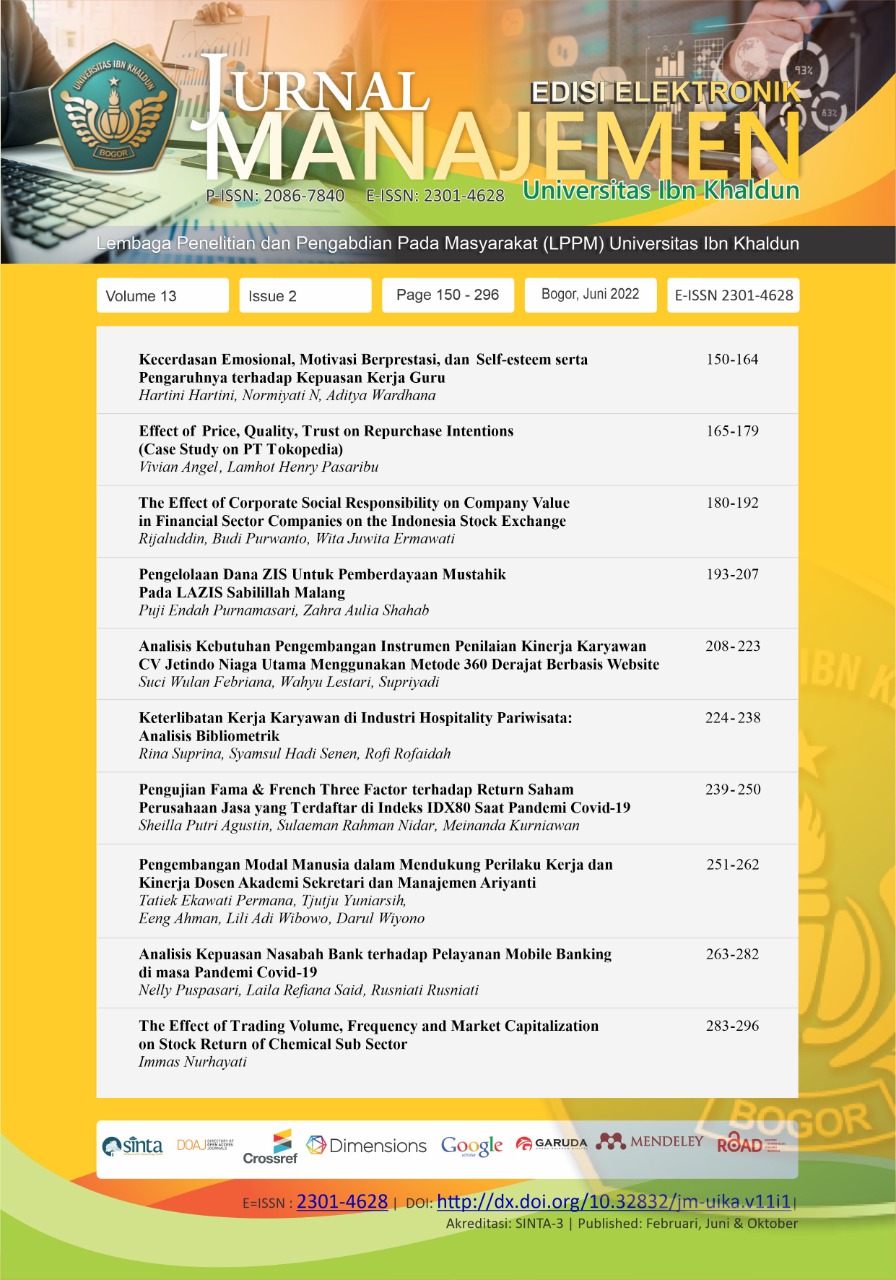Analisis Kebutuhan Pengembangan Instrumen Penilaian Kinerja Karyawan CV Jetindo Niaga Utama Menggunakan Metode 360 Derajat Berbasis Website
DOI:
https://doi.org/10.32832/jm-uika.v13i2.6068Kata Kunci:
Needs Analysis, Assessment Instrument, Employee Performance, The 360-degress MethodAbstrak
Needs analysis is a study whose information serves as the basis for developing a particular product. Researchers will collect information and data related to the development of employee assessment instruments through needs analysis. Employee performance assessment is one of the important indicators of the quality of the human resources department of an organization or company. This research uses descriptive methods with a qualitative approach. The subject of the study is the need for the development of employee assessment instruments CV Jetindo Niaga Utama, Semarang city, while the object of research is all employees from CV Jetindo Niaga Utama. Results from this research is, 1) the need for the development of employee assessment instruments using a website-based 360-degree method, and 2) factors that support and hinder the analysis of the need for the development of employee assessment instruments using a website-based 360-degree method. Based on the results of the needs analysis, almost all employees argue that the need to develop assessment instruments, indicated that 59% of employees answered in dire need of instrument development and 38% chose to require instrument development.. The results of this research will be used as a research basis for the development of CV Jetindo Niaga Utama employee assessment instruments using a website-based 360-degree methodReferensi
M. H. Songhori, "Introduction to Needs Analysis,” English Specif. Purp., no. 4, pp. 1–25, 2008.
A. Destianingsih and A. Satria, "A Study on Students' Need Analysis on Web-Based English Learning Materials,” Inovish J., vol. 2, no. 1, pp. 48–57, 2017.
B. Septiawan, "Management of Training Programs By Hrd Cv.Sultan Coffee Indonesia,” AKUNTABILITAS J. Ilm. Ilmu-Ilmu Ekon., vol. 14, no. 1, pp. 1–8, 2021, doi: 10.35457/akuntabilitas.v14i1.1522.
R. Yanuar Efranto, L. Riawati, and R. Setyoningtyas Dinaputri, "Perancangan Penilaian Kinerja Karyawan Pada Perusahaan Furniture dengan Metode 360 Degrees Feedback,” J. Eng. Manag. Industial Syst., vol. 3, no. 2, pp. 111–119, 2015, doi: 10.21776/ub.jemis.2015.003.02.8.
F. Sulistyawan, T. Wurijanto, and Y. Y. Subiyantoro, "Sistem Informasi Penilaian Kinerja Pegawai Menggunakan Metode Graphic Rating Scales dan 360 Derajat,” J. Sist. Inf., vol. 3, no. 2, pp. 7–13, 2013.
T. H. Handoko, Manajemen Personalia dan Sumber Daya Manusia. Yogyakarta, 2001.
R. Widya, "Penilaian Kinerja dengan Menggunakan Konsep 360 Derajat Feedback,” J. Ekon. dan Kewirausahaan, vol. 4, no. 1, p. 23346, 2004, [Online]. Available: http://ejurnal.unisri.ac.id/index.php/Ekonomi/article/view/163.
T. K. Chiew and S. S. Salim, "Webuse: Website usability evaluation tool,” Malaysian J. Comput. Sci., vol. 16, no. 1, pp. 47–57, 2003.
Madcoms, Aplikasi Web Database CSS PHP-MySQL untuk Pemula. Yogyakarta: Andi, 2011.
D. W. Yussanti and Y. Dwikurnaningsih, "Pengembangan Instrumen Penilaian Supervisi Manajerial Kepala Sekolah PAUD Berbasis Website,” Sch. J. Pendidik. dan Kebud., vol. 10, no. 3, pp. 217–230, 2020, doi: 10.24246/j.js.2020.v10.i3.p217-230.
Sugiyanto, "Pembuatan Website Profil Sekolah Menengah Kejuruan Pembangunan Nusantara Gabus Grobogan,” 2013, pp. 55–57.
R. Munajah and R. Setiawan, "Pengembangan Penilaian Otentik Berbasis Website,” J. Keilmuan dan Kependidikan Dasar, vol. 12, no. 02, pp. 89–102, 2020.
F. Handayani and W. Lestari, "Journal of Educational Research and Evaluation Need Analysis in The Development of HOTS-Oriented Study Project Assesment Instrument in Android-Based Science Learning,” Jere, vol. 8, no. 1, pp. 57–64, 2019, [Online]. Available: http://journal.unnes.ac.id/sju/index.php/jere.
R. Rifdarmon, "Analisis Kebutuhan Penilaian Psikomotor Berdasarkan Video Tutorial Berlandaskan Manualbook pada Pendidikan Vokasi Guna Meningkatkan Pencapaian Learning Target,” INVOTEK J. Inov. Vokasional dan Teknol., vol. 20, no. 3, pp. 89–96, 2020, doi: 10.24036/invotek.v20i3.738.
N. D. Lathifah and W. Lestari, "Needs Analysis On Zoom Meeting-Based Learning In Enhancing Elementary Students' Mathematic Communication Skill,” Proceeding Int. Conf. Islam. Educ., vol. 5, pp. 181–185, 2020.
U. S. Saud, A. Suryana, and U. Pendidikanindonesia, "Studi Efektivitas Penilaian Kinerja Kepala Smp Negeri,” J. Adm. Pendidik. Indones., vol. 23, no. 2, p. 161, 2016, doi: 10.17509/jap.v23i2.5643.
S. Y. Warella et al., Penilaian Kinerja Sumber Daya Manusia. 2021.
F. Fitriansyah, "Diklat Sebagai Organisasi Belajar Dalam Teknologi Kinerja,” Cakrawala, vol. 18, no. 1, pp. 44–49, 2018.
O. Arifudin, R. Tanjung, H. Hendar, and H. Hanafiah, "Analisis Pengaruh Penilaian Kinerja Dan Kompensasi Terhadap Produktivitas Kerja Pada PDAM Kabupaten Karawang,” J. Ilmu Manaj., vol. 10, no. 1, p. 71, 2020, doi: 10.32502/jimn.v10i1.2719.
M. Pattiasina, M. Roring, and W. Rumawas, "Pengaruh Kompetensi Sumber Daya Manusia Terhadap Kinerja Karyawan PT.Bank Tabungan Negara, Tbk. Kantor Cabang Manado,” J. Adm. BISNIS, vol. 4, no. 2, pp. 1–5, 2016.
E. B. Fortuna, "Pentingnya Kepemimpinan Spiritual terhadap Kinerja Karyawan,” vol. 2, no. 1, pp. 14–18, 2020.
D. Antonioni, "Designing An Effective 360-Degree Appraisal Feedback Process,” Autumn, vol. 25, no. 2, pp. 24–38, 1996.
L. D. Setia, "Evaluasi Usability Untuk Mengetahui Akseptabilitas Aplikasi Berbasis Web,” Multitek Indones., vol. 6, no. 1, p. 41, 2016, doi: 10.24269/mtkind.v6i1.1195.
Unduhan
Diterbitkan
Cara Mengutip
Terbitan
Bagian
Lisensi
Authors who publish with this journal agree to the following terms:
- Authors retain copyright and grant the journal right of first publication with the work simultaneously licensed under a Creative Commons Attribution-NonCommercial-ShareAlike 4.0 International License that allows others to share the work with an acknowledgement of the work's authorship and initial publication in this journal.
- Authors can enter into separate, additional contractual arrangements for the non-exclusive distribution of the journal's published version of the work (e.g., post it to an institutional repository or publish it in a book), with an acknowledgement of its initial publication in this journal.
- Authors are permitted and encouraged to post their work online (e.g., in institutional repositories or on their website) prior to and during the submission process, as it can lead to productive exchanges, as well as earlier and greater citation of published work (See The Effect of Open Access).











